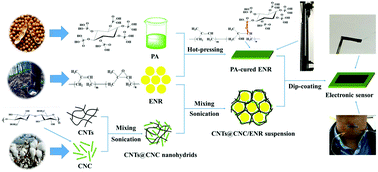Biological phytic acid as a multifunctional curing agent for elastomers: towards skin-touchable and flame retardant electronic sensors†
Abstract
Strain sensors have attracted extensive attention for wearable electronic applications. However, for many reported electronic sensors, the utilization of noxious agents brings about potential damage to human health and the inferior flame retardance increases the risk of circuits burning out. In this work, a skin-touchable and flame retardant electronic sensor is fabricated by integrating green chemistry with nanostructure design. Specifically, renewable and biocompatible phytic acid (PA) is used as a multifunctional curing agent to cross-link epoxidized natural rubber for the first time and the obtained elastomer exhibits excellent mechanical and flame retarding properties. Then, an electronic sensor is prepared by depositing a nanostructured conductive layer on the elastomer substrate for human-motion monitoring. The resultant sensor shows the abilities to precisely detect not only large-scale physiological activities (finger and wrist bending) but also small-scale human motions (such as speech, coughing and expression). Notably, the electronic sensor is capable of self-extinguishing after ignition owing to the presence of phosphorus-rich groups in the PA-cured elastomer and could come into contact with the skin at liberty. This highly sensitive, skin-touchable and noncombustible electronic sensor, together with its simplicity and eco-friendliness in fabrication, is attractive for next generation wearable electronics.



 Please wait while we load your content...
Please wait while we load your content...